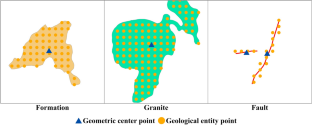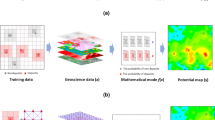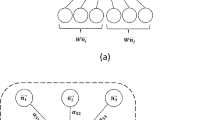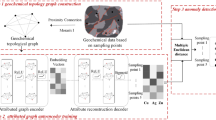Abstract
Graph-based models have been utilized for mineral prospectivity mapping (MPM), and they have demonstrated excellent performance owing to their adaptable graph structure, which is conducive to comprehensively considering the spatial anisotropy of mineralization compared with pixel- or image-based models. However, widely used graph-based models cannot fully consider the relationship between geological entities and mineralization. A heterogeneous graph is a type of graph structure containing rich heterogeneous information, allowing the consideration of various relationships and the assignment of suitable attributes to various types of nodes. Nodes in heterogeneous graphs can fully integrate heterogeneous information based on specific relations (i.e., edges). This study introduced a novel method for constructing heterogeneous graphs for MPM. The nodes in the graph consist of different types of geological entities, and the edges (relations) represent the links between the geological entities. The constructed heterogeneous graph cannot only effectively express the spatial anisotropy of mineralization but also consider the shape of geological entities and the relationships among geological entities, which is beneficial for modeling complex ore-forming geological processes. This heterogeneous graph was then trained using graph neural networks to obtain a mineral prospectivity map for southwestern Fujian Province, China. In addition, the proposed graph construction method demonstrated higher feasibility and accuracy in MPM compared to conventional graph construction method and convolutional neural networks.









Similar content being viewed by others
References
Ge, C., Han, F., Zhou, T., & Chen, D. (1981). Geological characteristics of the Makeng iron deposit of marine volcano-sedimentary origin. Acta Geoscientica Sinica, 3, 47–69. (in Chinese with English Abstract).
Gori, M., Monfardini, G., & Scarselli, F. (2005). A new model for learning in graph domains. IEEE International Joint Conference on Neural Networks, 2, 729–734.
Han, F., & Ge, C. (1983). Geological and geochemical features of submarine volcanic hydrothermal-sedimentary mineralization of Makeng iron deposit, Fujian Province. Collection from the Institute of Mineral Deposit Geology, Chinese Academy of Geological Sciences, 7, 1–118. (in Chinese with English Abstract).
Hu, Z., Dong, Y., Wang, K., & Sun, Y. (2020). Heterogeneous Graph Transformer. Proceedings of The Web Conference, 2020, 2704–2710.
Ji, H., Wang, X., Shi, C., Wang, B., & Yu, P. (2021). Heterogeneous Graph Propagation Network. IEEE Transactions on Knowledge and Data Engineering, 1–1.
Li, P., Yu, X., Li, H., Qiu, J., & Zhou, X. (2013). Jurassic-Cretaceous tectonic evolution of Southeast China: Geochronological and geochemical constraints of Yanshanian granitoids. International Geology Review, 55(10), 1202–1219.
Li, S., Chen, J., & Xiang, J. (2020). Applications of deep convolutional neural networks in prospecting prediction based on two-dimensional geological big data. Neural Computing and Applications, 32(7), 2037–2053.
Li, T., Zuo, R., Xiong, Y., & Peng, Y. (2021). Random-Drop Data Augmentation of Deep Convolutional Neural Network for Mineral Prospectivity Mapping. Natural Resources Research, 30(1), 27–38.
Rodriguez-Galiano, V. F., Chica-Olmo, M., & Chica-Rivas, M. (2014). Predictive modelling of gold potential with the integration of multisource information based on random forest: A case study on the Rodalquilar area, Southern Spain. International Journal of Geographical Information Science, 28(7), 1336–1354.
Scarselli, F., Gori, M., Tsoi, A. C., Hagenbuchner, M., & Monfardini, G. (2009). Computational capabilities of graph neural networks. IEEE Transactions on Neural Networks, 20, 81–102.
Shu, L., Faure, M., Wang, B., Zhou, X., & Song, B. (2008). Late Palaeozoic-Early Mesozoic geological features of South China: Response to the Indosinian collision events in Southeast Asia. Comptes Rendus Geoscience, 340(2–3), 151–165.
Singer, D. A. (2021). How Deep Learning Networks could be Designed to Locate Mineral Deposits. Journal of Earth Science, 32(2), 288–292.
Singer, D. A., & Kouda, R. (1996). Application of a feedforward neural network in the search for Kuroko deposits in the Hokuroku district. Japan. Mathematical Geology, 28(8), 1017–1023.
Sun, W., Ding, X., Hu, Y.-H., & Li, X.-H. (2007). The golden transformation of the Cretaceous plate subduction in the west Pacific. Earth and Planetary Science Letters, 262(3–4), 533–542.
Sun, Y., & Han, J. (2012). Mining heterogeneous information networks: A structural analysis approach. SIGKDD Explorations Newsletter, 14(2), 20–28.
Veličković, P., Cucurull, G., Casanova, A., Romero, A., Liò, P., & Bengio, Y. (2018). Graph attention networks. arXiv preprint arXiv: 1710.10903.
Wang, X., Ji, H., Shi, C., Wang, B., Cui, P., Yu, P., & Ye, Y. (2021). Heterogeneous Graph Attention Network (arXiv:1903.07293).
Wang, Z., & Zuo, R. (2022). Mineral prospectivity mapping using a joint singularity-based weighting method and long short-term memory network. Computers & Geosciences, 158, 104974.
Wang, Z., Zuo, R., & Zhang, Z. (2015). Spatial analysis of Fe deposits in Fujian Province, China: Implications for mineral exploration. Journal of Earth Science, 26(6), 813–820.
Xiong, Y., & Zuo, R. (2016). Recognition of geochemical anomalies using a deep autoencoder network. Computers & Geosciences, 86, 75–82.
Xiong, Y., & Zuo, R. (2018). GIS-based rare events logistic regression for mineral prospectivity mapping. Computers & Geosciences, 111, 18–25.
Xiong, Y., Zuo, R., & Carranza, E. J. M. (2018). Mapping mineral prospectivity through big data analytics and a deep learning algorithm. Ore Geology Reviews, 102, 811–817.
Xu, Y., & Zuo, R. (2024). An Interpretable Graph Attention Network for Mineral Prospectivity Mapping. Mathematical Geosciences, 56, 169–190.
Xu, Y., Zuo, R., & Zhang, G. (2023). The graph attention network and its post-hoc explanation for recognizing mineralization-related geochemical anomalies. Applied Geochemistry, 155, 105722.
Yang, F., Wang, Z., Zuo, R., Sun, S., & Zhou, B. (2023). Quantification of Uncertainty Associated with Evidence Layers in Mineral Prospectivity Mapping Using Direct Sampling and Convolutional Neural Network. Natural Resources Research, 32(1), 79–98.
Yang, N., Zhang, Z., Yang, J., & Hong, Z. (2022a). Applications of data augmentation in mineral prospectivity prediction based on convolutional neural networks. Computers & Geosciences, 161, 105075.
Yang, N., Zhang, Z., Yang, J., & Hong, Z. (2022b). Mineral Prospectivity Prediction by Integration of Convolutional Autoencoder Network and Random Forest. Natural Resources Research, 31(3), 1103–1119.
Yang, N., Zhang, Z., Yang, J., Hong, Z., & Shi, J. (2021). A convolutional neural network of GoogLeNet applied in mineral prospectivity prediction based on multi-source geoinformation. Natural Resources Research, 30(6), 3905–3923.
Yin, B., Zuo, R., & Xiong, Y. (2022). Mineral Prospectivity Mapping via Gated Recurrent Unit Model. Natural Resources Research, 31(4), 2065–2079.
Zhang, Y., Xiong, Y., Kong, X., Li, S., Mi, J., & Zhu, Y. (2018). Deep Collective Classification in Heterogeneous Information Networks. Proceedings of the 2018 World Wide Web Conference on World Wide Web - WWW ’18, 399–408.
Zhang, C., Song, D., Huang, C., Swami, A., & Chawla, N. V. (2019). Heterogeneous Graph Neural Network. Proceedings of the 25th ACM SIGKDD International Conference on Knowledge Discovery & Data Mining, 793–803.
Zhang, Z., & Zuo, R. (2014). Sr–Nd–Pb isotope systematics of magnetite: Implications for the genesis of Makeng Fe deposit, southern China. Ore Geology Reviews, 57, 53–60.
Zhang, Z., Zuo, R., & Cheng, Q. (2015a). Geological Features and Formation Processes of the Makeng Fe Deposit. China. Resource Geology, 65(3), 266–284.
Zhang, Z., Zuo, R., & Cheng, Q. (2015b). The mineralization age of the Makeng Fe deposit, South China: Implications from U-Pb and Sm–Nd geochronology. International Journal of Earth Sciences, 104(3), 663–682.
Zhang, Z., Zuo, R., & Xiong, Y. (2016). A comparative study of fuzzy weights of evidence and random forests for mapping mineral prospectivity for skarn-type Fe deposits in the southwestern Fujian metallogenic belt. China. Science China Earth Sciences, 59(3), 556–572.
Zhou, X., Sun, T., Shen, W., Shu, L., & Niu, Y. (2006). Petrogenesis of Mesozoic granitoids and volcanic rocks in South China: A response to tectonic evolution. Episodes, 29(1), 26–33.
Zuo, R. (2014). Identification of geochemical anomalies associated with mineralization in the Fanshan district, Fujian, China. Journal of Geochemical Exploration, 139, 170–176.
Zuo, R. (2016). A nonlinear controlling function of geological features on magmatic–hydrothermal mineralization. Scientific Reports, 6(1), 27127.
Zuo, R., & Carranza, E. J. M. (2011). Support vector machine: A tool for mapping mineral prospectivity. Computers & Geosciences, 37(12), 1967–1975.
Zuo, R., Carranza, E. J. M., & Wang, J. (2016). Spatial analysis and visualization of exploration geochemical data. Earth-Science Reviews, 158, 9–18.
Zuo, R., & Wang, J. (2016). Fractal/multifractal modeling of geochemical data: A review. Journal of Geochemical Exploration, 164, 33–41.
Zuo, R., & Wang, Z. (2020). Effects of random negative training samples on mineral prospectivity mapping. Natural Resources Research, 29, 3443–3455.
Zuo, R., & Xu, Y. (2023). Graph Deep Learning Model for Mapping Mineral Prospectivity. Mathematical Geosciences, 55(1), 1–21.
Zuo, R., Zhang, Z., Zhang, D., Carranza, E. J. M., & Wang, H. (2015). Evaluation of uncertainty in mineral prospectivity mapping due to missing evidence: A case study with skarn-type Fe deposits in Southwestern Fujian Province, China. Ore Geology Reviews, 71, 502–515.
Acknowledgments
This study was jointed supported by the National Natural Science Foundation of China (42321001, 42172326) and the Natural Science Foundation of Hubei Province (China) (2023AFA001).
Author information
Authors and Affiliations
Corresponding author
Ethics declarations
Conflict of Interest
The authors declare that they have no known competing financial interests or personal relationships that could have appeared to influence the work reported in this paper.
Rights and permissions
Springer Nature or its licensor (e.g. a society or other partner) holds exclusive rights to this article under a publishing agreement with the author(s) or other rightsholder(s); author self-archiving of the accepted manuscript version of this article is solely governed by the terms of such publishing agreement and applicable law.
About this article
Cite this article
Shi, L., Xu, Y. & Zuo, R. A Heterogeneous Graph Construction Method for Mineral Prospectivity Mapping. Nat Resour Res (2024). https://doi.org/10.1007/s11053-024-10344-2
Received:
Accepted:
Published:
DOI: https://doi.org/10.1007/s11053-024-10344-2




